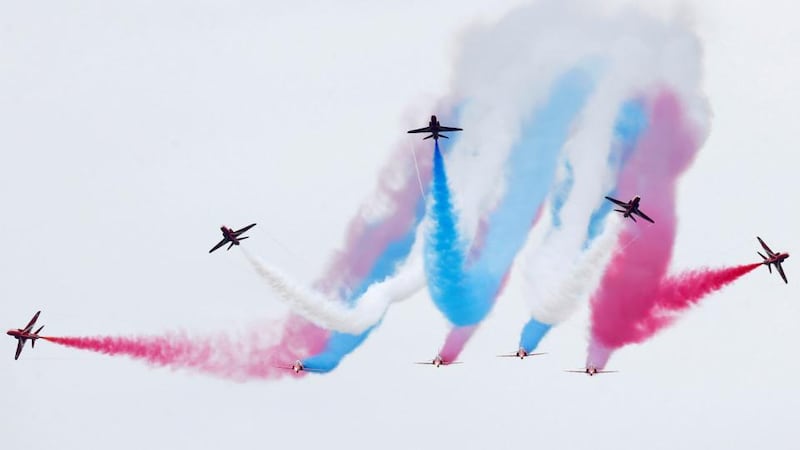The rain fell heavily, the campfires threw off acrid plumes of smoke, camp travellers edged forward carefully on slippery ground. The camp at Bannockburn in Stirlingshire, Scotland, was not happy on Saturday.
Seven hundred years after Robert the Bruce’s victory over Edward II, thousands had come to commemorate the battle and watch it re-enacted, not by soldiers but by actors. Standing under sailcloth tents, a few actors dressed in period clothes that included chain mail, complained about the lack of food.
“I’m not happy,” said a corpulent man there to play a role in Bruce’s army. “I’m not happy at all. This is absolutely ridiculous. I’m not eating vegetable curry, I’m not. I’m starting to feel dizzy.”

Backed by £500,000 of Scottish government funding, Bannockburn Live was intended to attract 45,000 over two days, but ticket sales disappointed the organisers. About 10,000 attended on Saturday but grumbles filled the air when those with the £20 tickets found they had to queue alongside others had yet to collect theirs.
Once inside they had to queue again to get to the viewing stands for the battle – not everybody made it, which led to more bickering, prompting apologies from organisers.
The battle scenes were humorously delivered: “Give it up for Robert the Bruce, hero of Scotland,” said the announcer.
“That’s pathetic,” he said after a feeble response. “This is a king we are talking about. Again!”
This time the crowd, enjoying a brief break in the rain, responded enthusiastically. The actors cantered through their scenes, which included Bruce’s early killing of Sir Henry de Bohun, his head cleaved with “my good axe“, and the arrival of an informer from the English camp. In the end the Scottish schiltrons – tightly packed groups of men armed with 3.5m spears – moved forward, breaking the English ranks to loud cheers. By now the rain had returned and was coming down more heavily.
“Thank you for witnessing this,” said the announcer as the crowds headed quickly for the gates. “Will the dead now rise,” he said to the actor soldiers.
Independence supporters, wearing the light blue badges of the Yes referendum campaign, were there in numbers, but doubters such as 60-year-old Stuart Thomson, who lives in Ayrshire, were there, too. “The heart says Yes, because of Bannockburn and things like it, but the head says No. I’d rather be a little fish in a big pond.”
Just one of the group with him, unwilling to be named, expressed an intention to vote Yes, and had little confidence of victory: “It won’t happen. I wish it would but it won’t.”
The re-enactors’ efforts to recreate the events of June 23rd and 24th, 1314, were disturbed intermittently by RAF Typhoon and Tornado fighter jets and Apache helicopters flying just a few miles away.
There, up to 35,000 people had attended Armed Forces Day. The event, in its sixth year, was brought to Scotland this year to heighten pro-Union sympathies.
British prime minister David Cameron stood in line on a country road, along with Labour leader Ed Miliband and Scottish first minister Alex Salmond to review the military parade. Each found something to illustrate their message about independence. For Cameron, the armed forces represented how Scotland and the rest of the UK were "better together".
For Salmond it was 92-year- old D-Day veteran Peter McCall, who joined the Scottish National Party in 1948 and “who is living” for Independence Day.
The dislike between the principals was evident. Cameron and Salmond had a cursory handshake. Defence secretary Philip Hammond ignored Miliband. Scottish Labour leader Johann Lamont, who has been overshadowed in the referendum campaign debate, stood at the end of the line, mostly ignored.
The dignitaries had to stand chatting for some time as they waited for the military parade from Stirling Castle to arrive. Sometimes attention waned. Miliband, lost in his thoughts, stared either into the middle distance, or, occasionally and with extraordinary concentration, at an officer’s gold-braided cap.
One veteran, Milton Reilly, told Salmond, Princess Anne and Cameron of his hopes that the UK would stay as one. Salmond quickly escaped. Cameron chatted but looked over Reilly’s shoulder for rescue. Leaving, later, the dignitaries attracted attention, though to varying degrees: Cameron some and Miliband very little, while Salmond received most – positive and negative but mostly the former.
In the crowd, three neighbours from Stirling, Alice Barber, Janis Clasn and Susan McKerchar, were united in their dislike of the idea of independence. “If this debate took place 300 years ago, fine,” said Clasn, “but we’re hundreds of years too late. Alex Salmond has not given enough clarity.”
For McKerchar, Ireland provided a salutary experience: “Look at what has happened there. It could happen to us. Look at the pay cuts. Here people complain if they get [a pay increase of] 1 per cent a year.” Tomorrow: the shipbuilding unions and their attitude towards independence










